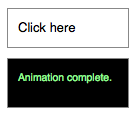.hide()
.hide( ) Returns: jQuery
Description: Hide the matched elements.
-
version added: 1.0.hide()
-
version added: 1.0.hide( duration [, callback] )
durationA string or number determining how long the animation will run.
callbackA function to call once the animation is complete.
-
version added: 1.4.3.hide( [duration] [, easing] [, callback] )
durationA string or number determining how long the animation will run.
easingA string indicating which easing function to use for the transition.
callbackA function to call once the animation is complete.
With no parameters, the .hide() method is the simplest way to hide an element:
$('.target').hide();
The matched elements will be hidden immediately, with no animation. This is roughly equivalent to calling .css('display', 'none'), except that the value of the display property is saved in jQuery's data cache so that display can later be restored to its initial value. If an element has a display value of inline, then is hidden and shown, it will once again be displayed inline.
When a duration is provided, .hide() becomes an animation method. The .hide() method animates the width, height, and opacity of the matched elements simultaneously. When these properties reach 0, the display style property is set to none to ensure that the element no longer affects the layout of the page.
Durations are given in milliseconds; higher values indicate slower animations, not faster ones. The strings 'fast' and 'slow' can be supplied to indicate durations of 200 and 600 milliseconds, respectively.
As of jQuery 1.4.3, an optional string naming an easing function may be used. Easing functions specify the speed at which the animation progresses at different points within the animation. The only easing implementations in the jQuery library are the default, called swing, and one that progresses at a constant pace, called linear. More easing functions are available with the use of plug-ins, most notably the jQuery UI suite.
If supplied, the callback is fired once the animation is complete. This can be useful for stringing different animations together in sequence. The callback is not sent any arguments, but this is set to the DOM element being animated. If multiple elements are animated, it is important to note that the callback is executed once per matched element, not once for the animation as a whole.
We can animate any element, such as a simple image:
<div id="clickme">
Click here
</div>
<img id="book" src="book.png" alt="" width="100" height="123" />
With the element initially shown, we can hide it slowly:
$('#clickme').click(function() {
$('#book').hide('slow', function() {
alert('Animation complete.');
});
});




Additional Notes:
- All jQuery effects, including
.hide(), can be turned off globally by settingjQuery.fx.off = true, which effectively sets the duration to 0. For more information, see jQuery.fx.off.
Examples:
Example: Hides all paragraphs then the link on click.
<!DOCTYPE html>
<html>
<head>
<script src="http://code.jquery.com/jquery-1.7rc2.js"></script>
</head>
<body>
<p>Hello</p>
<a >Click to hide me too</a>
<p>Here is another paragraph</p>
<script>
$("p").hide();
$("a").click(function ( event ) {
event.preventDefault();
$(this).hide();
});
</script>
</body>
</html>Example: Animates all shown paragraphs to hide slowly, completing the animation within 600 milliseconds.
<!DOCTYPE html>
<html>
<head>
<style>
p { background:#dad; font-weight:bold; }
</style>
<script src="http://code.jquery.com/jquery-1.7rc2.js"></script>
</head>
<body>
<button>Hide 'em</button>
<p>Hiya</p>
<p>Such interesting text, eh?</p>
<script>
$("button").click(function () {
$("p").hide("slow");
});
</script>
</body>
</html>Example: Animates all spans (words in this case) to hide fastly, completing each animation within 200 milliseconds. Once each animation is done, it starts the next one.
<!DOCTYPE html>
<html>
<head>
<style>
span { background:#def3ca; padding:3px; float:left; }
</style>
<script src="http://code.jquery.com/jquery-1.7rc2.js"></script>
</head>
<body>
<button id="hidr">Hide</button>
<button id="showr">Show</button>
<div>
<span>Once</span> <span>upon</span> <span>a</span>
<span>time</span> <span>there</span> <span>were</span>
<span>three</span> <span>programmers...</span>
</div>
<script>
$("#hidr").click(function () {
$("span:last-child").hide("fast", function () {
// use callee so don't have to name the function
$(this).prev().hide("fast", arguments.callee);
});
});
$("#showr").click(function () {
$("span").show(2000);
});
</script>
</body>
</html>Example: Hides the divs when clicked over 2 seconds, then removes the div element when its hidden. Try clicking on more than one box at a time.
<!DOCTYPE html>
<html>
<head>
<style>
div { background:#ece023; width:30px;
height:40px; margin:2px; float:left; }
</style>
<script src="http://code.jquery.com/jquery-1.7rc2.js"></script>
</head>
<body>
<div></div>
<script>
for (var i = 0; i < 5; i++) {
$("<div>").appendTo(document.body);
}
$("div").click(function () {
$(this).hide(2000, function () {
$(this).remove();
});
});
</script>
</body>
</html>